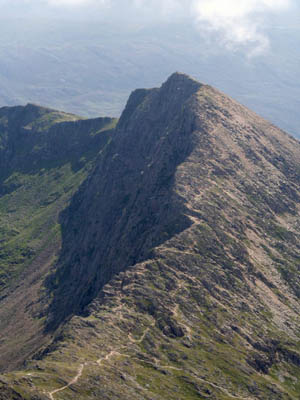
Y Lliwedd. Photo: Placid Casual
A group of climbers has come in for flak from rescuers who spent eight hours getting them off a Snowdonia crag.
More than 40 volunteers from three teams were at the scene overnight after three climbers were spotted, stuck on Y Lliwedd, by walkers on the Miner’s Track below. The climbers, a father, his son and a friend of the father, were attempted the Bilberry Terrace scramble but strayed off route and became cragfast.
Ian Henderson, secretary of the Llanberis Mountain Rescue Team which, along with colleagues from the Ogwen Valley and RAF Valley teams, was involved in the rescue, said: “The climbing leader, who expressed his surprise at getting stuck because of his E2-leading ability, became stuck on a sheer face facing outwards precariously on one foothold somewhere in the region of Ridge Route.
“Rescuers questioned the decision to attempt a Grade-3 scramble on a mountain face 1000 ft high, beginning the climb at lunch time and only taking one headtorch.”
Rescuers, who began their operation at 9 o’clock last night and were on the mountain until 5am today, catalogued a list of how-not-to-do-it acts by the party of three, from Liverpool and Stoke-on-Trent.
They left no note of their intentions at their bed-and-breakfast accommodation; they had no helmets and, though they were wearing climbing harnesses, their 30m rope was in a rucksack.
Two of the rescuers had to abseil more than 150m (500ft) to get to the three, who has spent many hours trapped in freezing conditions on the crag, which rises to the 896m (2,946ft) summit of Y Lliwedd on the Snowdon horseshoe.
After reaching the stricken climbers, rescuers hauled the trio to the top of the crag, from where they walked off, uninjured.
A total of 41 mountain rescue team members were involved in the operation, which also involved a Sea King helicopter from RAF Valley on Anglesey.
Y Lliwedd’s northern and eastern crags rise from Llyn Llydaw and present many climbing and scrambling challenges. Viewed by many as the birthplace of British rockclimbing, the crags of the ridge were used extensively for training by ill fated Everest mountaineer George Mallory and later by the successful 1953 expedition that put Tenzing Norgay and Sir Edmund Hillary on top of the world’s highest peak.
A grade E2 climb is the second stage in the Extremely Severe classification of British rock climbing.
The British scrambling grade system now runs from Grade 1 to Grade 4, in ascending order of difficulty. A Grade 3 scramble involves pitches of simple rock climbing on which rope protection is strongly advised. Dry conditions may be essential and skills in rope work are required because of lack of escape routes.
Some guides now rate Bilberry Terrace as Grade 4, because of its 1,000ft of scrambling ascent. Grade 4 routes might include rock climbing up to a Very Difficult grade.
Duncan Clark
23 February 2009Good report and I'd like to add something to the 'how not to do it' list.
As one of the 'walkers on the miners track' who alerted the authorities, my group was probably the last on the hill (we stayed out as it happens) and spent some time communicating by torch and voice with the rescued party.
They will be able to confirm this because the signal I was giving was 3 overhead arcs, plus we were shouting across the valley to each other at abou 18.30.
I hope we provided some reassurance, and I'm glad everyone is safe but guys...
6 blasts on a whistle (carry one) or torch flashes, response being 3 long ones as we mostly know. At some stages there were so many flashes (41 in a row)that members of my group were convinced it was just climbers mucking about!
I've put a short report on our news column at www.northridgeadventure.co.uk and if you want to see the conditions there are some photos at our open Facebook group.
Duncan Clark
02 March 2009Just as an update..I was delighted last week to be tracked down through this piece by one of the rescued party, who phoned to say thanks.
That small gesture really meant a lot to me and the folks I was with that night, so thanks guys, and good luck in the future!